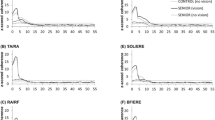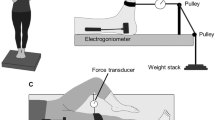Abstract
The purpose of this study was to characterize postural sway in quiet standing under eyes-open and eyes-closed conditions, and to obtain a measure of postural stiffness during quiet standing in adults with Down syndrome (DS) versus control subjects. We obtained descriptive measures from centre-of-pressure (COP) data and analysed and compared COP trajectories and postural stiffness estimates from two stochastic models, the “pinned polymer” (PP) and “inverted pendulum” (IP) models. These estimates were correlated with clinical measures of muscle tone. Our results showed that overall, estimated values for postural stiffness from both models were larger for the DS group than for normal controls. In addition, average stiffness measures were greater under the eyes-closed condition than under the eyes-open condition for the DS group. The IP model detected significant trends over trials whereas the PP model did not. Clinical assessment of muscle tone for the DS group ranged from low to high-normal and there was no significant correlation with the postural stiffness measures obtained from either model. These results suggest that individuals with DS have the ability to modulate their underlying “stiffness” under conditions of quiet standing. Furthermore, there appears to be no strong relationship between clinical measures of muscle tone and postural stiffness measures under dynamic conditions.






Similar content being viewed by others
References
Almeida GL, Marconi NF, Tortoza C, Ferreira SMS, Gottlieb GL, Corcos DM (2000). Sensorimotor deficits in Down syndrome: implications for facilitating motor performance. In: Weeks DJ, Chua R, Elliott D (eds) Perceptual-Motor behavior in Down syndrome. Human Kinetics, Champaign IL, pp 151–174
Aruin AS, Almeida GL (1997) A co-activation strategy in anticipatory postural adjustments in persons with Down syndrome. Motor Control 1:178–191
Aruin AS, Almeida GL, Latash, ML (1996) Organization of a simple two-joint synergy in individuals with Down syndrome. Am J Ment Retard 101:256–268
Butterworth G, Cicchetti D (1978) Visual calibration of posture in normal and motor retarded Down’s syndrome infants. Perception 7:513–25
Chiari L, Cappello A, Lenzi D, Croce UD (2000) An improved technique for the extraction of stochastic parameters from stabilograms. Gait Posture 12:225–234
Chow CC, Collins JJ (1995) Pinned polymer model of posture control. Physical Review E 52:907–912
Collins JJ, De Luca CJ (1993) Open-loop and closed-loop control of posture: a random-walk analysis of center-of-pressure trajectories. Exp Brain Res 95:308–318
Collins JJ, De Luca CJ (1994) Random walking during quiet standing. Phys Rev Lett 73:764–767
Cowie VA (1970) A study of the early development of Mongols. Pergamon, Oxford
Diggle PJ, Liang K, Zeger SL (1999) Analysis of longitudinal data. Oxford University Press, Oxford
Dubowitz V (1980) The floppy infant, 2nd edn. Clinics in developmental medicine no. 76. Spastics International Publications. Heinemann, London
Harris SR (1985) Neuromotor development of infants with Down syndrome. Dev Med Child Neurol 27:99–100
Hodges NJ, Cunningham SJ, Lyons J, Kerr TL, Elliott, D (1995) Visual feedback processing and goal-directed movements in adults with Down syndrome. APAQ 12:176–186
Hunt PM, Virji-Babul N (2002) Development of a quantitative measure of hypotonia for individuals with Down syndrome: a pilot study. Physiother Can 54:37–41
Latash ML (2000) Motor coordination in Down syndrome: the role of adaptive changes. In: Weeks DJ, Chua R, Elliott D (eds) Perceptual-motor behavior in Down syndrome. Human Kinetics, Champaign IL, pp 199–223
Latash ML, Anson JG (1996) What are “normal movements” in atypical populations? Behav Brain Sci 19:55–68
Latash ML, Almeida GL, Corcos DM (1993) Pre-programmed reactions in individuals with Down syndrome: the effects of instruction and predictability of the perturbation. Arch Phys Med Rehabil 73:391–399
Lauk M, Chow CC, Lipsitz LA, Mitchell SA, Collins JJ (1999) Assessing muscle stiffness from quiet stance in Parkinson’s disease. Muscle Nerve 22:635–639
Lydic JS, Steele C (1979) Assessment of the quality of sitting and gait patterns in children with Down syndrome. Phys Ther 59:1489–1494
Moore DS, McCabe GP (1993) Introduction to the practice of statistics, 2nd edn. WH Freeman, New York
Morasso PG, Schieppati M (1999) Can muscle stiffness alone stabilize upright standing? J Neurophysiol 83:1622–1626
Morris AF, Vaughan SE, Vaccaro P (1982) Measurements of neuromuscular tone and strength in Down’s syndrome children. J Mental Defic Res 26:41–46
Nardone A, Galante M, Lucas B, Schieppati M (2001) Stance control is not affected by paresis and reflex hyperexcitability: the case of spastic patients. J Neurol Neurosurg Psychiatry 70:635–643
Pomeroy VM, Dean D, Skyes L, Faragher EB, Yates M, Tyrrell PJ, Moss S, Tallis RC (2000) The unreliability of clinical measures of muscle tone: implications for stroke therapy. Age Aging 29:229–233
Press W, Flannery B, Teukolsky S, Vetterling W (1990) Numerical recipes The art of scientific computing (FORTRAN version). Cambridge University Press, New York
Shumway-Cook A, Woollacott MH (1985) Dynamics of postural control in the child with Down syndrome. Physical Therapy, vol 65, no 9
Vieregge P, Schulze-Rava H, Wessel K (1996) Quantifaction of postural sway in adult Down’s syndrome. Dev Brain Dysfunct 9:211–214
Vuillerme N, Marin L, Debû B (2001). Assessment of static postural control in teenagers with Down syndrome. APAQ 18:417–433
Winter DA (1990) Biomechanics and motor control of human movement, 2nd edn. Wiley, New York
Winter DA, Patla AE, Prince F, Ishac M, Gielo-Perczak K (1998) Stiffness control of balance in quiet standing. J Neurophysiol 80:1211–1221
Author information
Authors and Affiliations
Corresponding author
Rights and permissions
About this article
Cite this article
Webber, A., Virji-Babul, N., Edwards, R. et al. Stiffness and postural stability in adults with Down syndrome. Exp Brain Res 155, 450–458 (2004). https://doi.org/10.1007/s00221-003-1743-7
Received:
Accepted:
Published:
Issue Date:
DOI: https://doi.org/10.1007/s00221-003-1743-7




